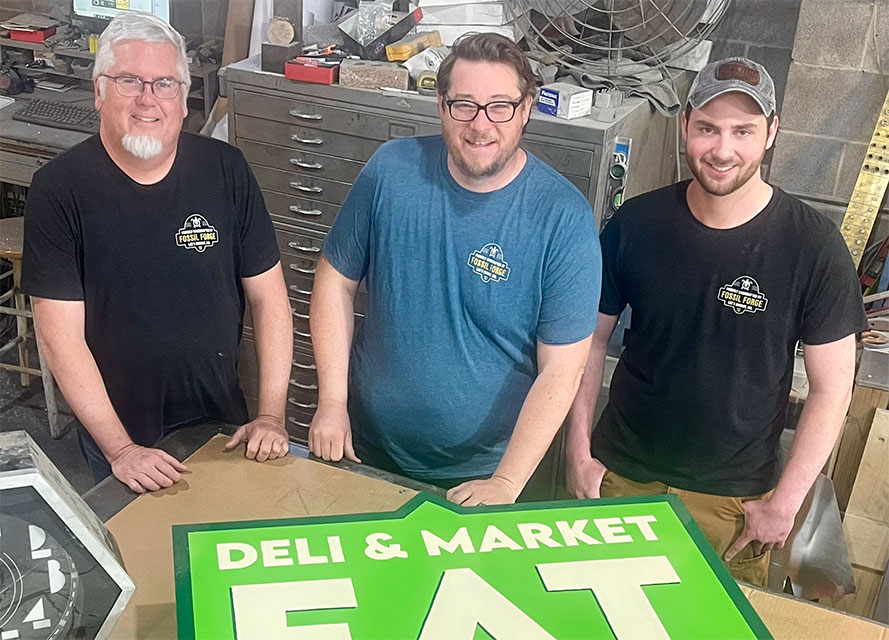Dave Eames, Ben Wine, and Remy Norton-Hood of Fossil Forge Design, a shop that has excelled at sign restorations.
The art of sign restorations is a craft that Dave Eames and Ben Wine have truly mastered. As co-owners of Fossil Forge Design in downtown Lee’s Summit, Missouri, they, along with their colleague Remy Norton-Hood, have become key players in the realm of sign projects and neon restorations throughout Missouri and the Midwest.
Established by Eames in 2015, Fossil Forge Design is strategically located in the heart of Lee’s Summit, within a prosperous and bustling downtown area boasting an impressive 99 percent business occupancy rate. The three-person shop has left its mark on numerous neon restoration projects, contributing to the revival of traditional signage throughout the region.
Eames reflects on the unique charm of Lee’s Summit’s downtown area, particularly as evening falls. He notes, “I would put our city up, pound for pound, against almost anywhere else when you roll into the downtown area at dusk. It resembles the way cities used to look fifty or sixty years ago before so much of the neon and traditional signage was stripped from them.”
Wine, who became a partner at Fossil Forge Design in 2017, brings a wealth of experience to the table, having been involved in collecting and restoring neon signs since 2009. His passion for neon, coupled with an appreciation for the mechanical intricacies of signage, is evident. “We love old signs—and old signs even better when they’re back where they belong,” he affirms.
Together, Eames and Wine have not only preserved the history embedded in these signs but have also played a vital role in restoring the aesthetic character of Lee’s Summit’s downtown, creating a nostalgic atmosphere reminiscent of bygone eras. Their commitment to the art of sign restoration is a testament to the importance of preserving the visual heritage that defines a community.
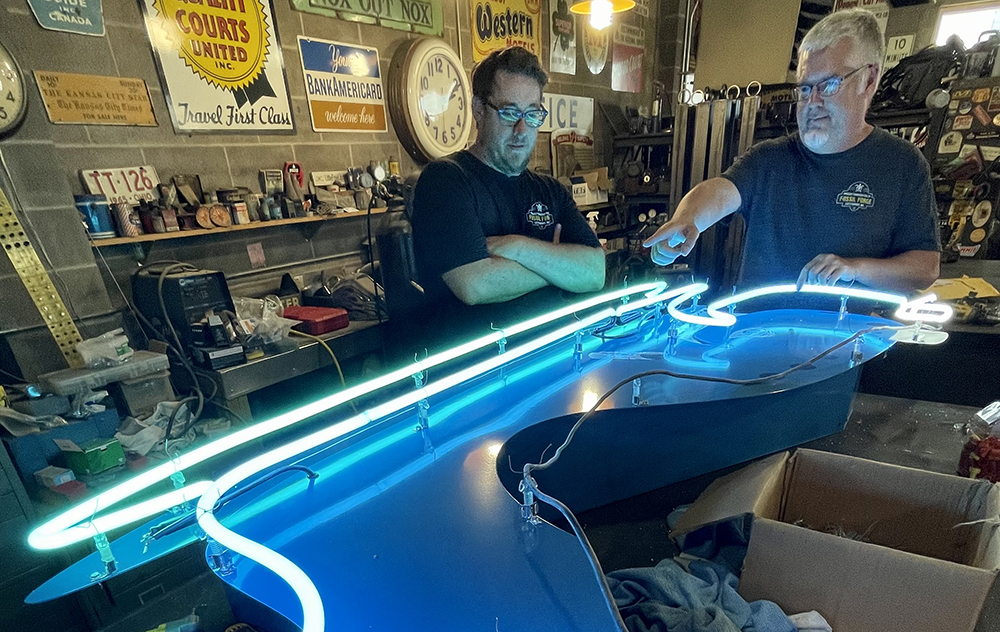 Wine and Eames work on a neon sign restoration.
Wine and Eames work on a neon sign restoration.
The workshop at Fossil Forge Design spans an expansive 2,000 square feet, with a predominant focus on the production area, complemented by a compact office space. The layout is thoughtfully organized, comprising distinct sections dedicated to various facets of their craft.
The neon space serves as a specialized zone within the workshop, housing the delicate work associated with neon sign restoration. Adjacent to this, there’s an area equipped with routers and a plasma cutter, essential tools for precision cutting and shaping. Another designated section is allocated for metal and wood working tools, facilitating a comprehensive range of fabrication techniques.
Eames highlights the versatility of their workshop, emphasizing the advantage of a central open space. He remarks, “The nice thing is we have a larger space in the center of our shop where we can bring in old signage or build new signage and still have a little bit of space around us.” This central area provides the flexibility needed for handling both the restoration of vintage signs and the creation of new, custom signage.
Despite being a compact team of three, Fossil Forge Design boasts a broad spectrum of capabilities. Wine explains, “We’re small, as there’s only three of us here, but we can do anything from design and fabrication work all the way to installation.” This comprehensive approach allows them to seamlessly navigate projects, ranging from intricate sign restorations to crafting custom metal works, murals, and various other multimedia endeavors. Their ability to manage the entire creative process underscores the depth of their expertise and commitment to delivering high-quality work across diverse projects.
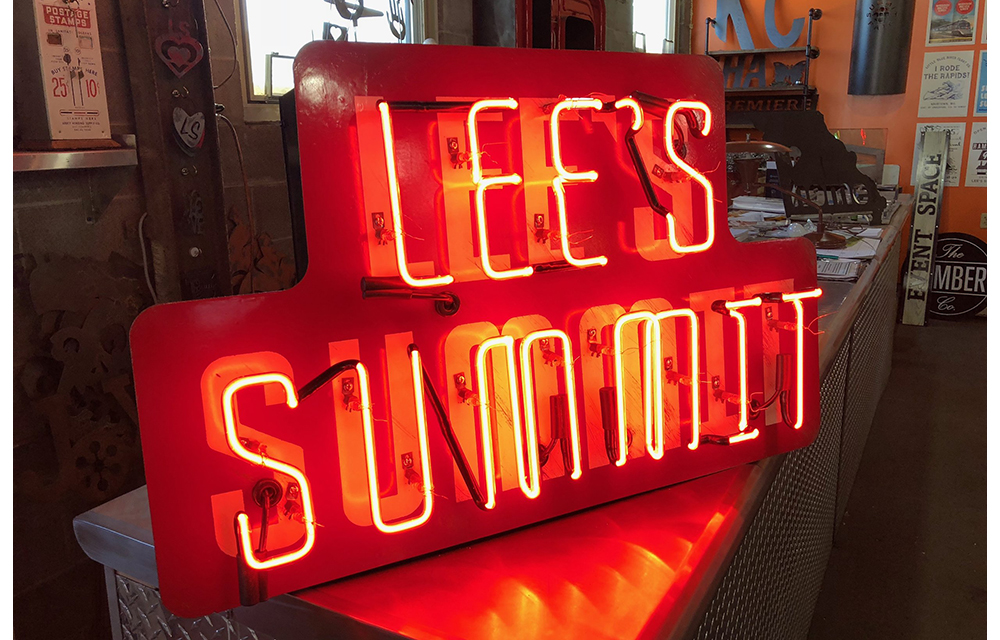 Thanks to the efforts of Fossil Forge Design and city planners, Lee’s Summit has welcomed back colorful neon pieces.
Thanks to the efforts of Fossil Forge Design and city planners, Lee’s Summit has welcomed back colorful neon pieces.
In a surprising twist, despite downtown Lee’s Summit now being adorned with vibrant neon pieces, the city once had an ordinance that expressly prohibited this luminous component in the area. Thanks to the determined efforts of Eames, Wine, and a collective of advocates, including city planners, the ordinance underwent a transformative modification in 2017, ushering in a new era that embraced neon signage. Eames reflects on this pivotal change, stating, “When the ordinance change took place, there were zero neon signs here in the downtown area. Now there are more than twenty exterior neon signs with metal cans.”
The close collaboration between Eames, Wine, and the city planners played a crucial role in this shift. Located a mere 200 yards away from the town’s planning department, Fossil Forge Design enjoys a favorable relationship with local authorities. This proximity has facilitated a dynamic exchange of ideas and a smooth process for navigating the intricacies of city regulations.
What sets many of Fossil Forge Design’s sign restorations apart is their transformation into art pieces rather than mere advertisements. This unique approach affords the team some flexibility with permitting. Eames notes, “I believe the city likes what we’re doing, so they’re giving us an opportunity to work with them on how we permit some signs.” This collaborative spirit not only showcases the aesthetic appreciation for their work but also exemplifies the city’s recognition of the positive impact that the restoration and installation of these neon signs have on the overall ambiance of downtown Lee’s Summit.
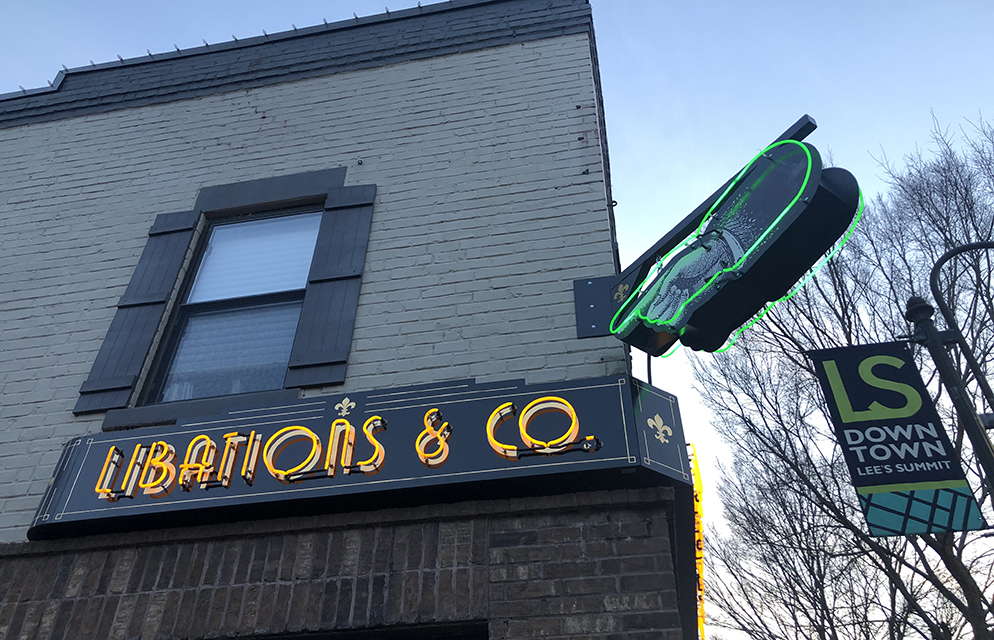 There are now more than twenty exterior neon signs with metal cans in Lee’s Summit.
There are now more than twenty exterior neon signs with metal cans in Lee’s Summit.
Fossil Forge Design deliberately steers clear of the conventional paths taken by other shops in the area, carving out a niche that revolves around authentic sign restorations and the creation of new signage with a genuine aesthetic. According to Eames, the company adheres staunchly to traditional sign-making techniques and materials, emphasizing a commitment to preserving the authenticity of the original pieces during restoration. He expresses their philosophy, stating, “We’re big believers in traditional sign-making techniques and materials. If the sign can be saved, we would prefer to use the correct materials for it.”
While the team does engage in LED retrofits for more commercial plastic pan signs and channel letters, Wine emphasizes that when it comes to designs featuring exposed tubing, they steadfastly stick to neon. This dedication to neon in such instances ensures the preservation of the classic, timeless appeal that neon signs bring to the urban landscape.
The design process at Fossil Forge Design is characterized by a straightforward approach. Eames and Wine initiate the creative journey by meeting with the customer to understand their vision, followed by the generation of sketches and measurements. Subsequently, they craft proposal renderings of each sign and its placement using Adobe Illustrator. Eames notes, “This helps with estimating material costs. Then we’ll send it off to the customer.”
A distinctive strength of Fossil Forge Design lies in the conceptualization phase, where the team’s creativity shines. Eames emphasizes, “The concepts we come up with for customers are one of the shop’s strengths. It helps them make the connection.” This unique ability to bridge the gap between client expectations and the creative vision exemplifies the artistry and customer-centric approach that define Fossil Forge Design’s contributions to the world of sign craftsmanship.
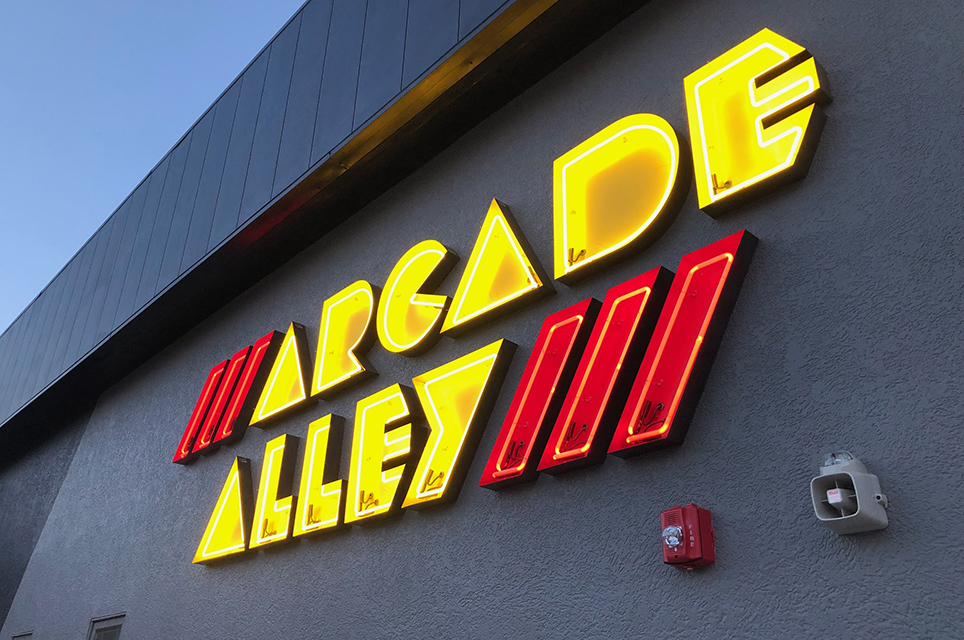 Example of a neon sign that Fossil Forge Design recently fabricated and installed.
Example of a neon sign that Fossil Forge Design recently fabricated and installed.
In managing customer expectations, Eames underscores the importance of transparent communication. The team at Fossil Forge Design keeps customers informed through email updates in case of potential challenges, such as complexities in the sign build, permitting issues, or weather-related installation delays. Eames emphasizes, “Communication, like everything in life, is the foundation.”
Wine adds insights into their customer relationships, noting that while they specialize in unique projects, their clientele understands the rarity of shops offering such specialized work. He mentions, “We do a lot of specialized work, but our customers realize that there’s not a lot of places around that do this type of work. So they’re a little more understanding for something that’s quality rather than something they can get from a handful of places around the corner.”
Turning to recent projects, Eames and Wine took on the restoration of a 1950s-built neon sign from the historic Topsy’s Café in Concordia, Missouri. This particular sign, removed in the early ’60s, was believed by locals to still exist in the cafe’s attic. New owners, during the building’s renovation, discovered the sign in the attic and reached out to Missouri Main Street for guidance on restoring it. Fossil Forge Design, known for its collaboration with Missouri Main Street, was enlisted for the project.
Eames vividly describes their initial encounter with the Topsy’s sign, likening it to entering King Tut’s tomb. “We saw it as if we were walking into King Tut’s tomb,” says Eames, recalling the first time they saw the Topsy’s sign in the attic. “We love small town cafes. We just wanted to help the new owners succeed.”
This project not only showcases Fossil Forge Design’s expertise in neon sign restoration but also reflects their dedication to preserving the historical and cultural elements embedded in these iconic signs. The passion for their craft extends beyond the workshop, embracing a sense of community and a commitment to contributing to the success of local establishments.
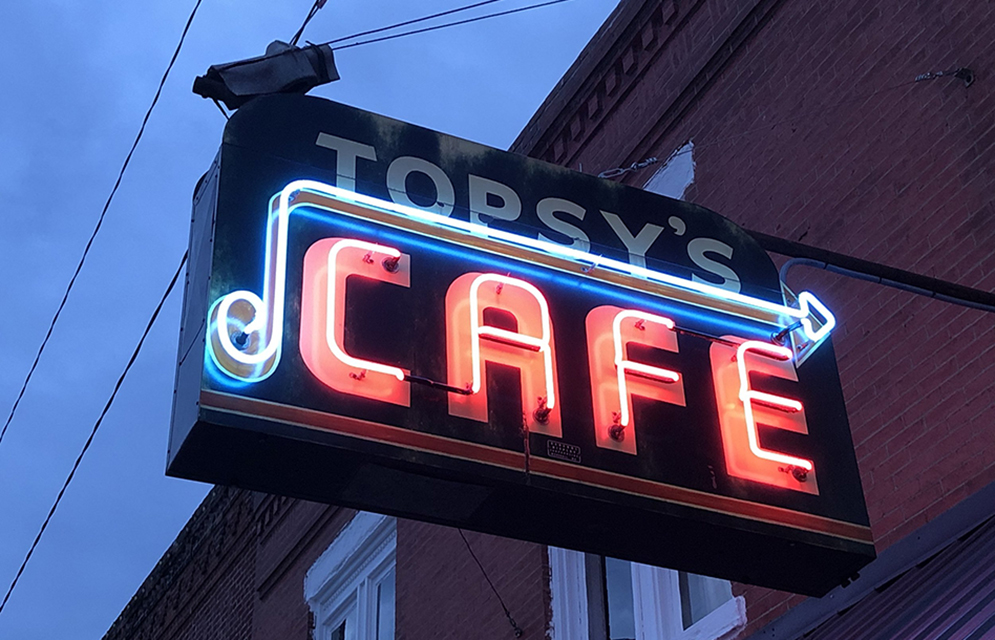 The restored Topsy’s Café sign in Concordia, Missouri.
The restored Topsy’s Café sign in Concordia, Missouri.
Eames and Wine transported the hefty six-foot-wide-by-four-foot-tall Topsy’s Café sign back to their workshop, its weight a testament to its solid steel construction. Undeterred by the weight, Fossil Forge Design eagerly set about restoring the iconic piece.
In the workshop, they meticulously tinkered with the wiring and connected the internal mechanisms and flasher to power supplies. To their delight, everything still worked flawlessly. Eames explains their preservation approach, stating, “With the exception of one piece of neon, we left the original neon as it was, as it was still stable and had rich colors. We only had to have one piece of glass made.”
Preserving the sign’s history, the team opted to clean it while leaving the old patina intact, in line with the client’s preference. Eames notes, “The client wanted us to leave it on there, and we did too!” After incorporating a new transformer and GTO wiring, the sign was resurrected, reclaiming its former glory after six decades of dormancy. Although it now serves more as an art installation attached to the building, its revival is a testament to Fossil Forge Design’s dedication to preserving and celebrating the heritage of iconic signs.
Following this successful restoration, Eames and Wine embarked on a two-hour journey to Pulaski County, Missouri, to undertake a monumental project at the Uranus Fudge Factory, situated off Historic Route 66 in the unincorporated area known as Uranus. This ambitious endeavor encompasses a diverse range of elements, including 2D/3D components, metal works, animated neon, and a painted mural designed to captivate travelers on the famed highway.
Eames reflects on the significance of this project, asserting, “It’s been our biggest project we’ve had in the history of Fossil Forge Design—the scale of it, the location of it, what it means, and its potential influences for them and us.” Celebrating the intertwined heritage of neon signs and the historic highway, this project stands as a pinnacle achievement in the world of Fossil Forge Design, marking a testament to their creativity, skill, and commitment to preserving and contributing to the cultural fabric of their community.
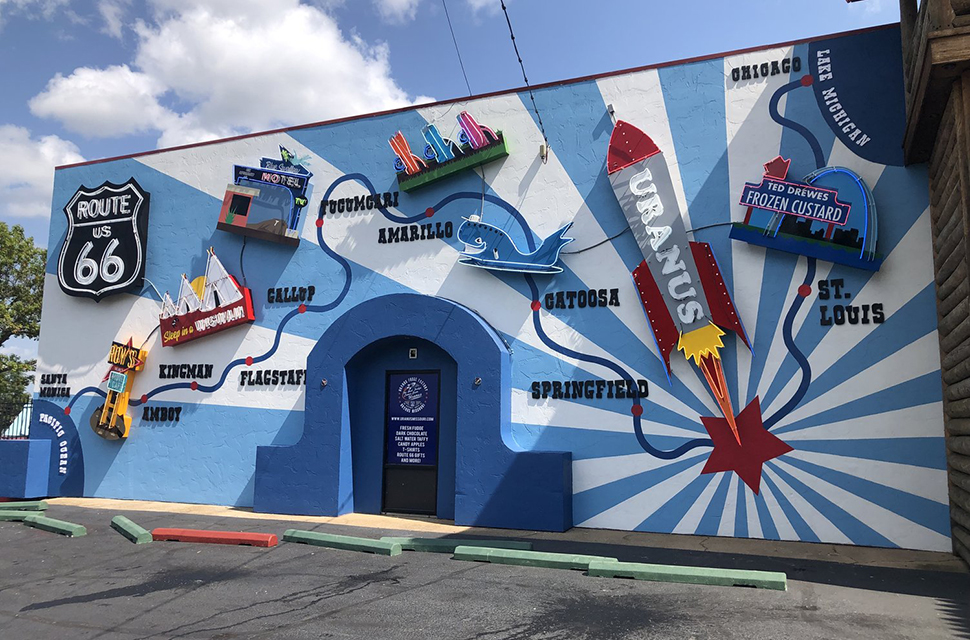 The Uranus Fudge Factory project incorporated 2D/3D elements, metal works, animated neon, and a painted mural.
The Uranus Fudge Factory project incorporated 2D/3D elements, metal works, animated neon, and a painted mural.
At the Uranus Fudge Factory, Owner Louie Keene entrusted Fossil Forge Design with the creative freedom to craft a captivating Route 66-themed mural on a substantial blank wall within their development—an artistic endeavor aimed at enticing travelers off the iconic highway. Eames recounts the collaborative process, stating, “He gave us a list of landmarks he wanted to see on it, and we picked from there.”
In response to this creative challenge, Fossil Forge Design not only painted a striking mural featuring a stylized map as the backdrop but also crafted a total of eight brand-new neon signs. Each neon sign served as a visual representation of significant landmarks and historical elements along the historic Route 66. This multifaceted project seamlessly merged artistry with storytelling, providing travelers with a visual journey through the iconic highway’s rich history and cultural significance.
The collaboration between Fossil Forge Design and the Uranus Fudge Factory exemplifies the company’s ability to translate their passion for neon signage into immersive, narrative-driven installations that contribute to the cultural landscape. The project not only celebrates the heritage of Route 66 but also stands as a testament to the power of creative collaboration between businesses and artists in enhancing the roadside experience for travelers.
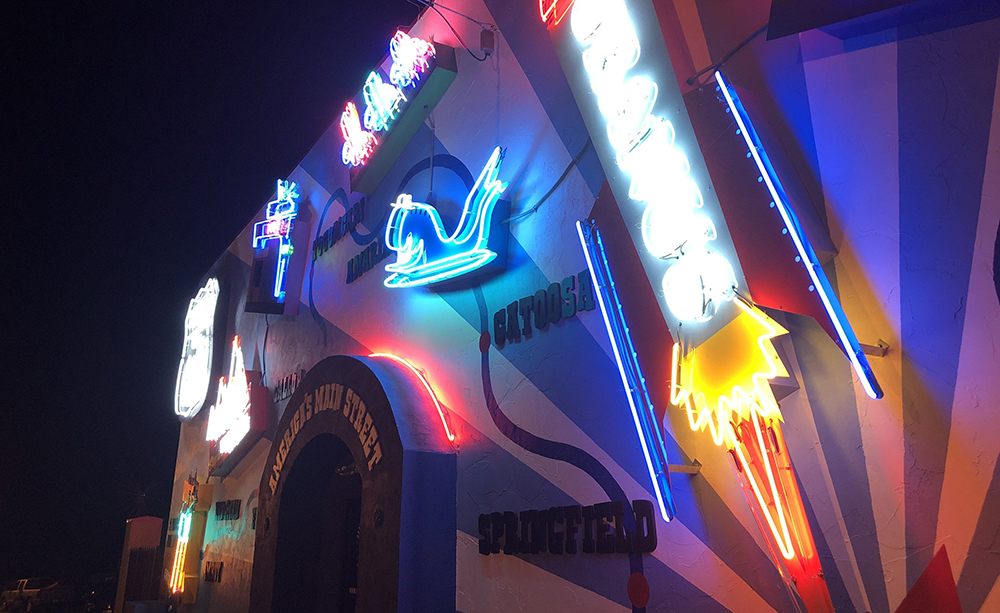 The Uranus Fudge Factory mural at night.
The Uranus Fudge Factory mural at night.
“This is not just a job for us; we are invested in this emotionally,” Eames passionately asserts. “It’s good for Missouri, good for Route 66, and good for the country. This keeps small shops like ours out front.”
Returning to downtown Lee’s Summit, Eames and Wine took on the challenge of creating a new version of the Vogue Theater sign, located just across the street from their workshop. The Vogue Theater, a striking example of Art Deco architecture, was originally built in 1940 and once stood as a vibrant and beautiful Midwestern cinema. Unfortunately, over the years, it lost its popularity and succumbed to disrepair, leading to its eventual demolition. In its place, a new condominium was erected, and the Homeowners Association (HOA) expressed a desire for a facsimile replica of the original marquee to serve as a homage within the new development.
Fossil Forge Design eagerly embraced this opportunity to contribute to the restoration of a piece of local history. Eames reflects on the significance of the project, stating, “Everybody always talked about the old theater, but most of us alive today never really saw it.” This sentiment underscores the emotional investment that the team at Fossil Forge Design brings to their work—a commitment not just to their craft but to the preservation and reimagining of the cultural fabric of their community. Their dedication to reviving iconic landmarks like the Vogue Theater marquee exemplifies the role of small shops in maintaining and celebrating the historical richness of their surroundings.
 The new Vogue Theater neon sign.
The new Vogue Theater neon sign.
Determined to revive the essence of the Vogue Theater marquee, Eames and Wine delved into a trove of photographs and old color home movies, meticulously studying the details to ensure an authentic recreation of the neon elements.
Fossil Forge Design took on the task of crafting and painting all the cans and letters, striving to capture the essence of the original design. For the crucial neon tubing component, they enlisted the expertise of their neighbors at Gama Neon.
The resulting twenty-foot-tall sign comprises two ten-foot cans housing exposed open-face channel letters. Fossil Forge Design, committed to authenticity, painstakingly painted the letters to closely match the original colors. Recognizing the need to distinguish the new marquee as a replica rather than an exact duplicate, they incorporated a few modern details while maintaining the overall vintage aesthetic.
Installation of the “new old” sign was executed with precision, utilizing Fossil Forge Design’s fifty-foot boom truck. Initial concerns about potential disruptions for residents in adjacent condos due to the glowing light at night were dispelled with a pleasant surprise. Eames shares, “One of the coolest compliments we got was that those tenants love it because it creates a beautiful, soft glow in their apartments and acts a little bit like a night light.” This positive feedback not only reflects the success of the project in terms of design and execution but also underscores the unintended yet welcomed impact it has had on the local community, contributing to the charm and ambiance of the area.
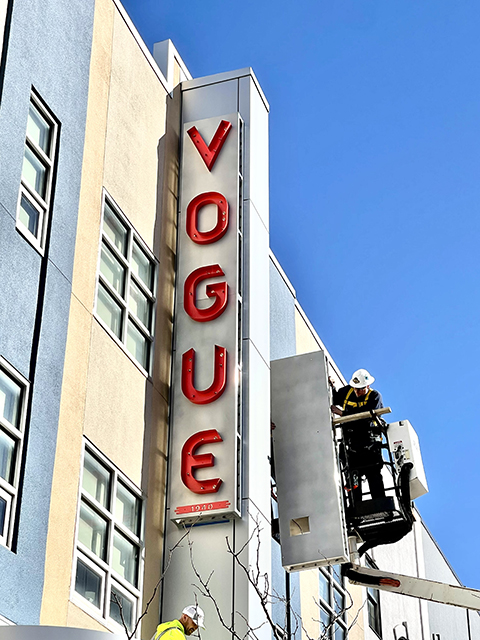
Fossil Forge Design used a fifty-foot boom truck to install the Vogue Theater sign.
In 2022 and early 2023, Fossil Forge Design left a vibrant mark on the heart of Lee’s Summit, installing numerous new neon signs. For Eames, the most gratifying aspect has been witnessing visitors to the downtown area marvel at the brilliance of their creations.
“It pushes our compass in that direction more than money or anything else, because that’s sort of a legacy for a very small company in a fairly small city in the middle of America,” he reflects. “To be able to have these things hang in our town that people are proud of and because they’re proud of them, they’re going to work hard to make sure that our city stays cool and is headed in the right direction.”
Looking ahead, Fossil Forge Design has ambitious plans for sign restorations involving iconic neon and metal signage in both Independence and Kansas City, Missouri. Eames expresses pride in the role his company plays, stating, “We’re proud to present a colorful history of the sign as the first personality and voice of our towns and cities.” He emphasizes the importance of looking back at the vibrancy, light, and motion of mid-century signage, reflecting on how Main Streets once dazzled with unique and memorable signage.
“So many towns presented a bright and optimistic face to visitors and residents,” Eames adds. “We’re happy to bring that back.” This sentiment encapsulates Fossil Forge Design’s commitment to not only reviving the visual heritage of communities but also contributing to the sense of pride and optimism that iconic signage can instill in a city’s identity.
